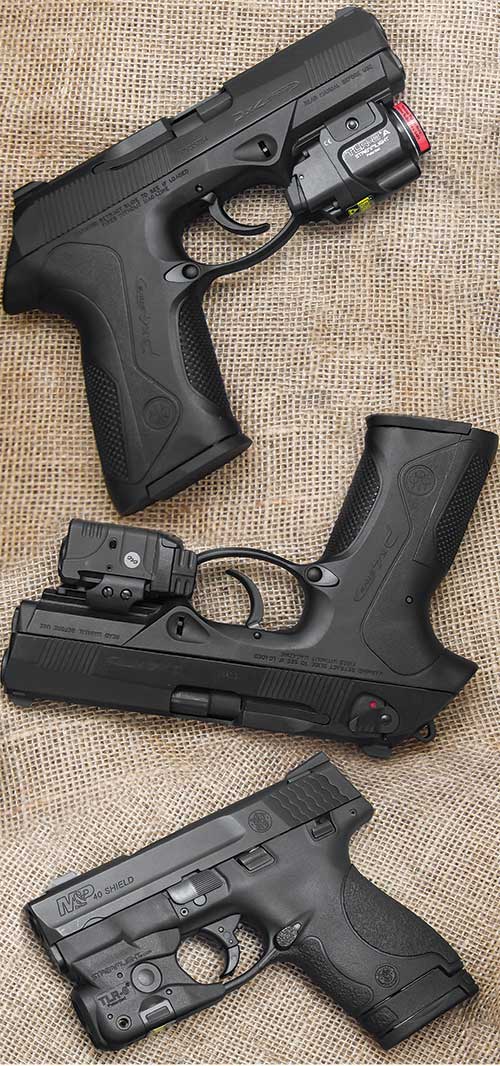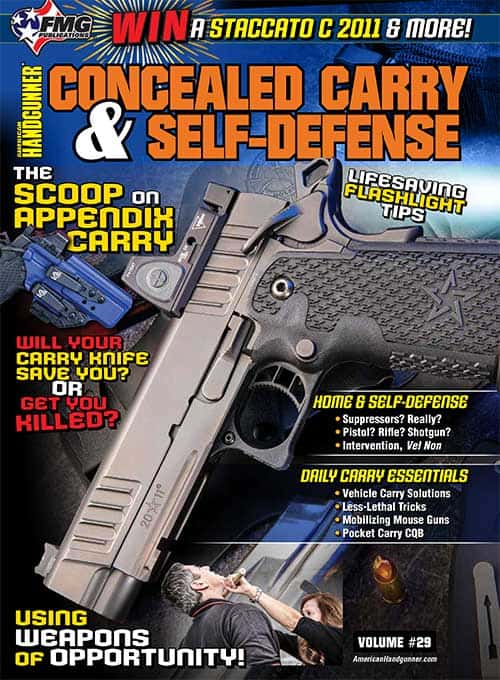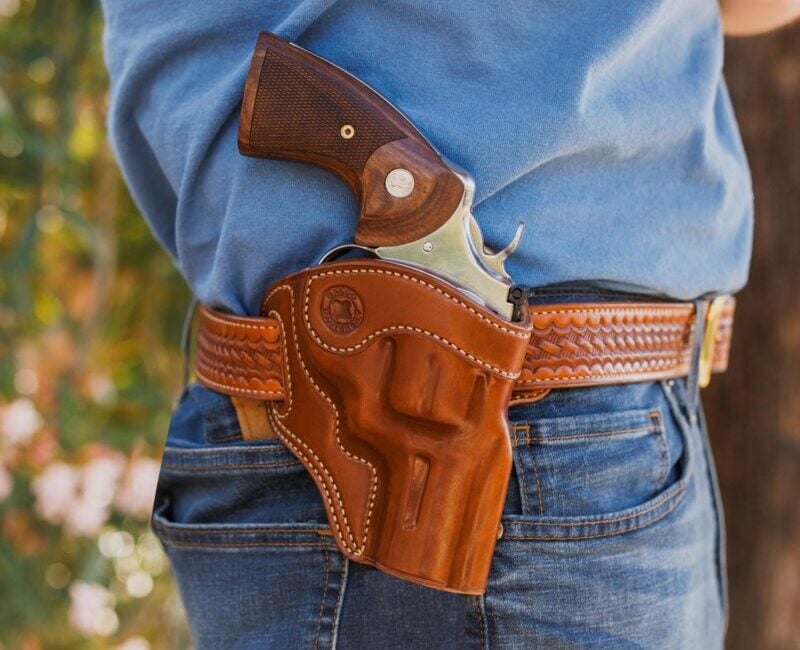Go To The Light!
How to make darkness your ally
It’s no secret most violent encounters happen during dusk or darkness, so one might look at it as a disadvantage for the good guys like us. But is it? It depends on how you respond. If you know how the eye responds to darkness along with how and when to use light properly, you might just turn what appears to be a handicap into a tactical advantage.
I spent the majority of my police career on the midnight shift, so the tactical use of light became almost second nature for me. Darkness does create some problems, but it can also provide some significant advantages.
Let’s look at a typical traffic stop by a police officer at night. As soon as a suspect vehicle is stopped, the officer positions his patrol vehicle for maximum use of the tools available to him. In this case, he floods the stopped car with light from his headlights, blue lights, spotlight and even takedown lights. The driver who has become accustomed to his night vision suddenly experiences sensory overload. The officer then seemingly appears out of the darkness — his movement being concealed by a wall of light. He is then likely to shine his flashlight directly in the eyes of the occupants as he scans the vehicle for hazards. The end effect is to put the occupants at a disadvantage by impairing their ability to see.
On the other end of the spectrum, the same officer may have to enter a warehouse where he finds an open door at night. Here, he may be put at a tactical disadvantage going from a lighted parking lot into a partially or totally dark building. A bad guy in the building has already adapted to the darkness and can wait in the shadows for the officer’s approach. All of this has to do with how the human eye responds to changes in light. We’ve all experienced similar situations in our lives, so you don’t need to be an ophthalmologist. Use such knowledge to your benefit when operating in the dark. You can then use lighting options to your advantage and against the aggressor.
The equipment you choose to carry as a concealed carry holder is important. You want to have a compact yet powerful flashlight, a good weapon-mounted light or both. There is no shortage of great equipment available today. Like shooting, the most important element is not the equipment, but your knowledge and skill in using it properly. This is known as light control. You need to intelligently assess the situation and use light and darkness to help take control of it.
Light Tactics
The first question is if you need to use a light. Perhaps there is enough ambient light and the best option is just to use darkness. Bad guys hide in the dark all the time, so don’t discard it as an option. Chances are, however, you’re going to have to use a light at some point. So, the next questions become when and how. There is no way to explain every situation you might encounter, but here are some general guidelines you should know.
Use the light as sparingly as possible. Think of the classic movie scene showing police officers searching a warehouse with their lights on the entire time. It’s great for cinema, but horrible for survival. It gives away your position and movement and makes you an easy target.
Try to keep darkness behind you to avoid being silhouetted against a lighted background. If you have to move through a lighted area, do so quickly so you don’t look like one of those B-21 targets we like to practice on.
Use short bursts of light (generally a second or less) to see in dark areas. It’s plenty of time to check an area. If your bad guy is there, your light may temporarily destroy his night vision. Think of the effects of an oncoming car that refuses to dim the lights at night. It takes a few seconds or more to recover. The same thing applies here.
Always move after using light. Light tends to draw enemy fire, and you don’t what to be where the bad guy is now shooting. This also applies if and when you shoot. Your muzzle flash has the same effect.
Never pass an area you’ve not cleared of danger first.
Use sound control. Ambient sounds are usually reduced in hours of darkness, so sounds can give your position away as easily as light. You don’t want dangling keys or any extra equipment to bang against objects, and you want to move as quietly as possible. Do not shuffle your feet if not absolutely necessary. There are times when you may need to do this, but make sure you know when it is proper. Most of the time it’s not.
These are just a few basic rules to consider. There are many others you should know. Sometimes, however, the best way to learn low-light tactics is to practice them with a training partner in different situations to find what works and what doesn’t. It’s how most of these rules came about in the first place — trial and error. You can make it a nighttime version of hide-and-seek with kids using only flashlights. They usually enjoy such games, and it gives you knowledge and experience.
Gear Up!
Now it’s time to move onto equipment considerations. I’m a huge fan of lights and lasers and make no secret of it. But they are merely tools available to use if needed and not necessarily go-to items. Weapon-mounted lights (WML) or light/laser combinations are extremely popular today and for good reason — they are tacti-cool! I’m mostly kidding here. They are valuable tools to have if you’re using them properly. Violating the guidelines above, however, is definitely not cool!
Various weapon-mounted lights and light/laser combos are available in prices ranging from cheap to super expensive. The main criteria is quality. Anything you may have to use for self-defense must be utterly reliable. For this reason, it’s best to stick with companies that have a proven record of reliability. I use a number of Streamlight products because I know I can depend on them and they are reasonably priced. I also use Crimson Trace, SureFire and other products. Which option you choose depends on personal preference and the intended use.
I currently have a Crimson Trace CMR-205 mounted on my wife’s Beretta Px4 as a home-defense weapon. Its 100-lumen output is perfect for home defense and allows for target identification without too much light reflecting back on her (as could be the case for a 500-, 800- or 1,000-lumen light against our white walls).
I also have a Streamlight TRL-6 for my M&P Shield. This is a normal carry gun that serves double-duty as home-defense option. Both of these have lasers made into them that provide additional options. Used together, they allow you to focus on the threat and confidently engage it without having to depend on a traditional sight picture.
On the higher-power end of the spectrum, I use a Streamlight TRL-1 HL that usually mounts on a full-size M&P. With 500 lumens, it’s more for outdoor use. I think it’s overkill in my home. We all know target identification is crucial; 100 lumens get the job done for me inside.
Handheld
I also have Streamlight’s latest handheld flashlight, the Macrostream. It provides the option of 500 lumens (on high) or 50 (low) as needed. Initial target identification may be best with a separate light. I don’t want to accidently point my weapon-mounted light (with my attached gun) at someone who might simply be my daughter coming home late at night.
There are a number of similar additional reasons you might choose to only use a separate flashlight rather than a weapon-mounted light. It was a staple in the police world for decades, and a number of techniques were designed so it could be used effectively like a WML. I can think of at least six of them off the top of my head, but discussing those is for another time. I recommend you look up “Harries Hold” and “FBI technique.” It’s also helpful to learn how the human eye works during low-light conditions. Both can provide even more useful information.
Ultimately, your knowledge and skills create the true advantage. Knowledge is easy — just read. Skill development success depends on how dedicated you are to practice. Practice is the key. It will teach you what equipment works best in which environment, and that is what you need most.
One last comment: Don’t fall for the “brighter is always better” way of thinking. Concealed carry is defensive in nature. Unlike the police, you’re not required to conduct building searches or chase bad guys in most cases. Your job is to defend against them.
Learn all you can, practice diligently and carry on my friends.
For more info:










